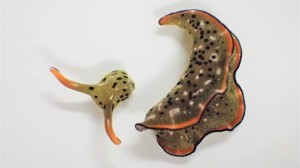Self-decapitating Sea Slugs

An Elysia marginata, a species of sea slug, is seen after shedding its body in an act of self-decapitation.
Credit: © Sayaka Mitoh
What’s slimy, shell-less, and can remove its own head?
A sea slug!
New research from Japan suggests that sea slugs of two closely related species—Elysia marginata and Elysia atroviridis—amputate (cut off) their own heads to grow new bodies. This act of self-amputation is an example of autotomy.
The decapitation is not for beauty reasons. A sea slug doesn’t think, “How about I switch things up? I want an oval-shaped body, rather than a tubelike one.” Instead, the researchers suspect that a sea slug nixes its noggin when its body becomes infected with a parasite. A parasite is a living thing that feeds off another living thing, called a host.
Not all sea slugs in the experiment cut off their heads. (But, to make up the difference, some slugs cut off their heads twice!) The headless bodies stayed alive for as long as months before decomposing (rotting). But even more surprisingly, the heads remained alive, eating and growing new tissue until they developed entirely new, parasite-free bodies.
For most of the sea slugs, the entire process of growing new tissue took less than a month. The head wounds healed in one day. Such organs as the heart took about one week to regenerate.
Although it is a major feat to grow an entirely new body in three weeks, sea slugs don’t need to grow too much. Most sea slugs are small, measuring less than 1 inch (2.5 centimeters) long. However, many kinds grow much larger. One group of sea slugs, called sea hares, has several large species, including one that can reach more than 2 feet (60 centimeters) in length. And although we’re just guessing, it would probably take more than a month to grow 2 feet of sea hare.
Sea slugs are not the first members of the animal kingdom to commit autotomy in self-defense. If a gecko is attacked, it can distract an enemy by waving its tail. When the enemy attacks the tail, the tail breaks off but keeps wriggling. While the enemy holds the tail, the gecko runs away. It soon grows a new tail. Starfish also practice autotomy. If grabbed, many starfish can drop off arms in order to defend themselves. They can then regenerate new arms to replace the old ones. If a starfish is cut into two or more pieces, each piece may become a new animal, as long as it contains a portion of the animal’s central disk.
The sea slug-studying scientists believe that understanding the growth process of sea slugs—as well as other animals—could lead to advances that enable people to regrow and replace damaged tissue, a field called regenerative medicine.


